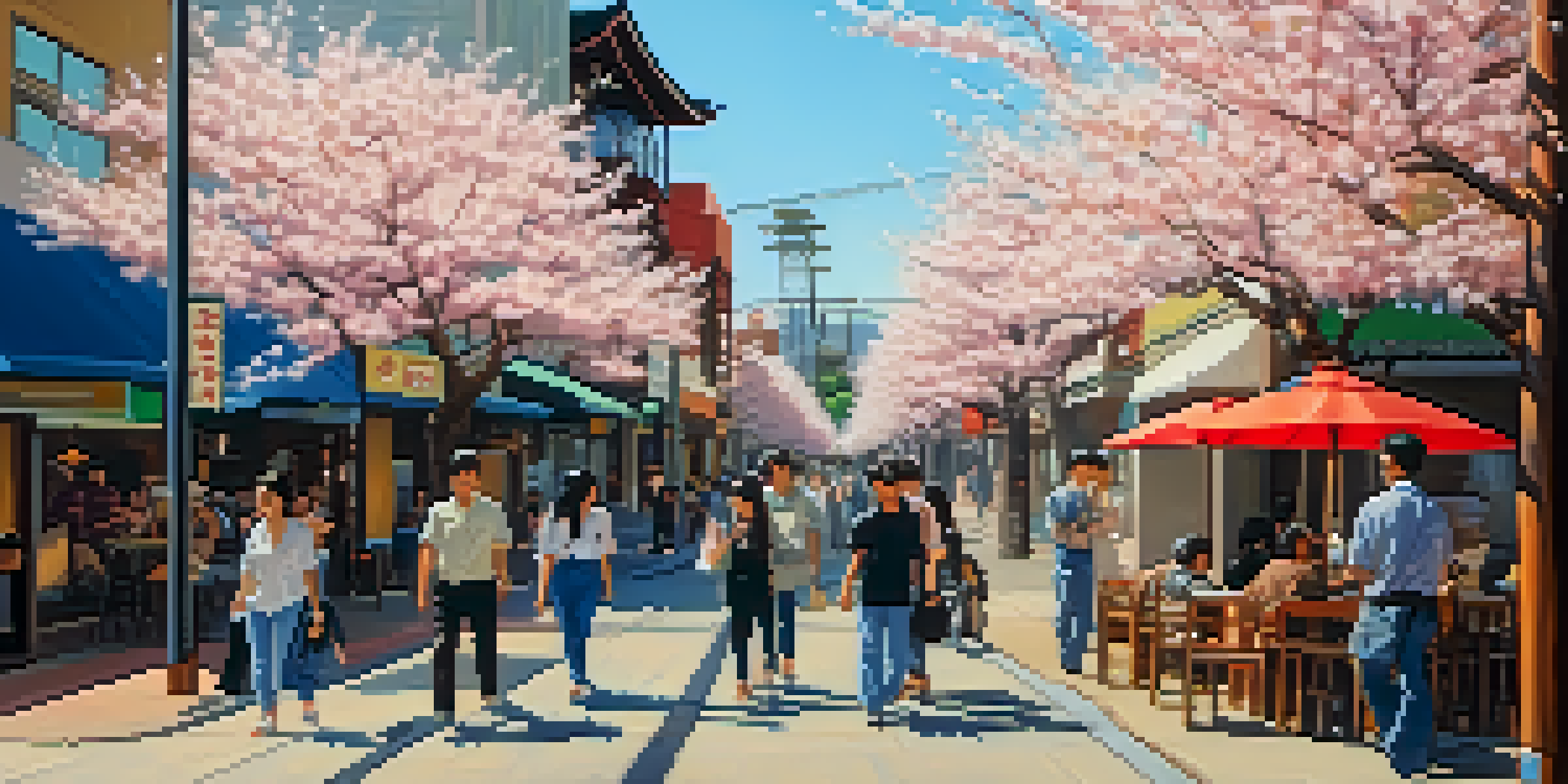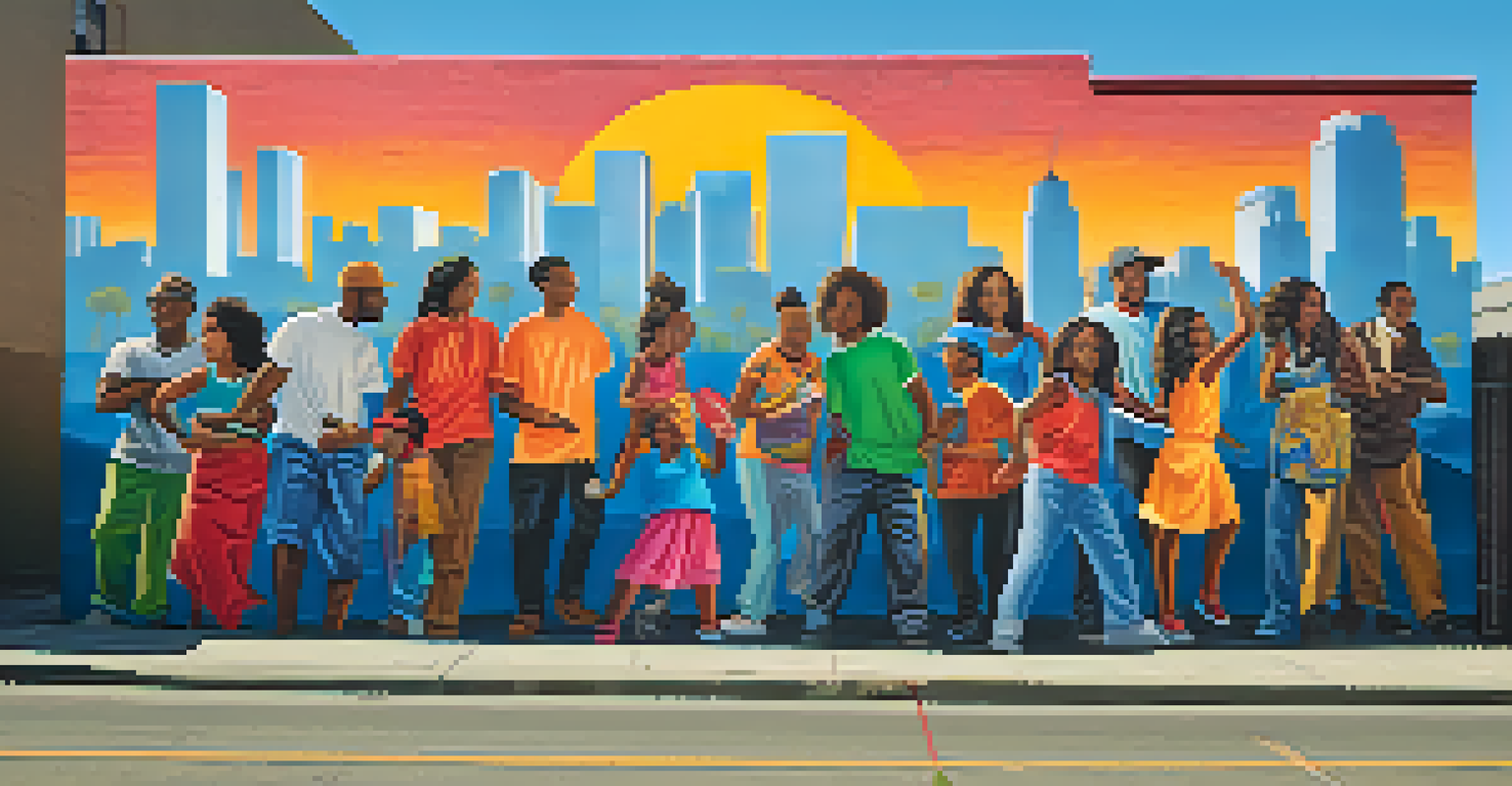The Evolution of LA's Neighborhoods: Stories Untold

The Origins: A Tapestry of Cultures and Communities
Los Angeles is not just a city; it's a mosaic of diverse neighborhoods, each with its unique story. From the early days of indigenous tribes to the arrival of Spanish settlers, LA's neighborhoods have always been shaped by cultural influences. This blend of cultures laid the groundwork for the vibrant communities we see today.
Los Angeles is a city of dreams, a place where the past and the future collide in a colorful tapestry of cultures and communities.
As immigrants from various parts of the world made their way to LA, they brought their customs, languages, and culinary flavors, enriching the city's social fabric. For example, the establishment of Little Tokyo in the early 20th century showcased Japanese culture and has since become a beloved destination for locals and tourists alike. This cultural cross-pollination is a hallmark of LA's evolution.
Understanding these origins helps us appreciate the complex identity of the city's neighborhoods. Each area tells a story of resilience, adaptation, and community spirit, reminding us that LA is a living history book filled with untold narratives.
Post-War Boom: The Rise of Suburbia
The end of World War II marked a significant shift in Los Angeles, as the economy boomed and suburban development flourished. Families flocked to the suburbs, transforming once-rural areas into thriving residential neighborhoods. This wave of growth not only altered the city's landscape but also its social dynamics.

The construction of the freeway system further fueled this suburban expansion, making commuting easier and more accessible. Neighborhoods like Westwood and Woodland Hills emerged, catering to a growing population seeking the American dream of homeownership. However, this rapid expansion also created challenges, such as urban sprawl and increased traffic congestion.
Cultural Diversity Shapes LA
Los Angeles is a vibrant mosaic of neighborhoods influenced by diverse cultures and histories.
As LA evolved, these suburbs began to develop their unique identities, often reflecting the aspirations and lifestyles of their residents. The post-war era is a testament to how economic and social factors can shape the very fabric of a city, leaving lasting impacts on its neighborhoods.
The Civil Rights Movement: Neighborhood Activism
The 1960s were a pivotal time for Los Angeles, as the civil rights movement ignited a wave of activism throughout the city. Neighborhoods such as South Central became epicenters for change, as residents fought against systemic injustices and inequities. This activism not only brought attention to the struggles of marginalized communities but also forged a sense of unity and purpose.
Art is the most beautiful of all lies; it is a way to tell the truth without hurting anyone.
Local leaders and organizations worked tirelessly to improve living conditions, education, and economic opportunities in their neighborhoods. Events like the Watts Riots in 1965 highlighted the deep-seated frustrations within the community, ultimately leading to a greater awareness of social issues. These struggles gave rise to a new generation of activists who were determined to make their voices heard.
The legacy of this era continues to shape LA's neighborhoods today, as many community organizations and initiatives still strive for equality and justice. The stories of resilience and perseverance during this period are often untold, yet they remain a crucial part of the city’s narrative.
Gentrification: The Double-Edged Sword
In recent decades, gentrification has become a pressing issue in many Los Angeles neighborhoods. As urban renewal projects and rising property values attract new residents, long-time inhabitants often face displacement. This phenomenon poses a complex challenge, as revitalization can bring both opportunity and upheaval.
Areas like Echo Park and Silver Lake have witnessed significant transformations, where once-affordable homes are replaced with trendy cafes and boutiques. While some celebrate the investment and growth, others mourn the loss of the cultural identity that defined these neighborhoods. The clash between old and new raises critical questions about who gets to call these spaces home.
Gentrification Challenges Communities
As neighborhoods undergo gentrification, the clash between new developments and long-time residents raises important questions about identity and displacement.
Gentrification illustrates the ongoing evolution of LA's neighborhoods, highlighting the delicate balance between progress and preservation. It's a reminder that while change is inevitable, the stories of those who lived there before should not be forgotten.
Cultural Renaissance: Arts and Innovation
As the 21st century unfolded, Los Angeles began to experience a cultural renaissance that breathed new life into its neighborhoods. Artists, musicians, and innovators flocked to areas like Downtown LA and Arts District, transforming them into vibrant hubs of creativity. This resurgence not only revitalized the local economy but also attracted a diverse crowd eager to engage with the arts.
Art galleries, performance spaces, and street murals became synonymous with these neighborhoods, showcasing the talents of both established and emerging artists. Events like the monthly Downtown Art Walk encouraged community participation and fostered a sense of belonging. This creative spirit is a testament to how art can unite and inspire a community.
The cultural renaissance in LA illustrates the power of creativity in shaping neighborhoods. It reminds us that underneath the hustle and bustle, there's a thriving artistic community that continues to tell the city's story through their work.
Environmental Awareness: Green Spaces and Sustainability
In recent years, there has been a growing emphasis on environmental awareness within LA's neighborhoods. With urbanization taking its toll, residents and organizations have begun advocating for green spaces and sustainability initiatives. Parks, community gardens, and eco-friendly projects have become essential components of neighborhood revitalization efforts.
Efforts to combat pollution and promote healthy living have led to initiatives like the creation of the Los Angeles River revitalization project, which aims to restore the river's natural habitat and create recreational spaces for residents. These projects not only enhance the quality of life but also foster a sense of community pride and responsibility.
Sustainability Drives Future Growth
A growing emphasis on environmental awareness is leading LA neighborhoods to prioritize green spaces and sustainable initiatives.
This shift towards sustainability highlights the interconnectedness of environmental health and neighborhood well-being. As residents champion these causes, they demonstrate that a community's evolution can also include a commitment to a greener future.
Looking Ahead: The Future of LA's Neighborhoods
The story of Los Angeles neighborhoods is far from over; in fact, it's still being written. As the city continues to grow and evolve, future generations will undoubtedly shape its neighborhoods in new and exciting ways. The challenges of housing affordability, climate change, and social equity will require innovative solutions and collaborative efforts.
Community engagement will be crucial in determining the direction of these neighborhoods. As residents come together to address local issues, they can ensure that their voices are heard and their needs are met. This participatory approach is essential for fostering inclusive and vibrant communities.

In reflecting on LA's evolution, we see a city that is constantly adapting while honoring its rich history. The stories untold will continue to emerge, reminding us that every neighborhood has a unique narrative waiting to be discovered.